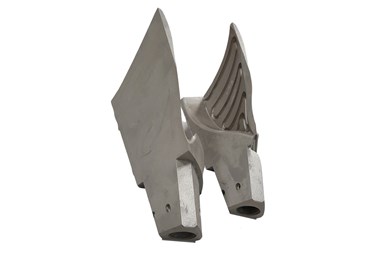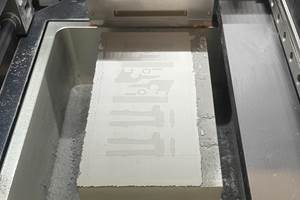AddUp AISI 420 Steel Enables More Complex, Efficient Injection Tooling Molds
This stainless steel is commonly used to manufacture molds for plastic injection molding, as it has both high mechanical strength and good corrosion resistance.
Share
Read Next
AddUp’s shaping AISI 420 steel is commonly used in the field of plastic injection and can now be used for additive manufacturing (AM). The company says AISI 420 steel can enable tooling manufacturers to develop new, more complex and more efficient molds. The material is now available for all FormUp 350 New Generation Powder Bed Fusion (PBF) machines.
AddUp, a joint venture created by Michelin and Fives, says it is one of the first players in the metal 3D printing sector to offer a recipe for implementing AISI 420 steel. Also referred to in the German standard as 1.4021 or 1.2083, this stainless steel is commonly used to manufacture molds for plastic injection molding, as it has both high mechanical strength and good corrosion resistance.
This development for AISI 420 adds to its broad portfolio of materials for the tooling sector, including 316L stainless steel and Maraging 300 (M300) steel. AddUp’s experience with these materials has enabled the production of millions of parts for tire molds.
The company says the shaping AISI 420 steel is compatible with existing postprocessing solutions. By proposing a recipe for AISI 420 steel, a grade that has proven itself in the production of plastic injection molds, AddUp is betting on rapid adoption by industrialists in the tooling field.
“Unlike alloys specially designed for additive manufacturing, which require users to invest in developing suitable postprocessing, we offer here a widely used grade,” says Frédéric Sar, AddUp materials manager. “With AISI 420, the post-printing operations are identical to those of parts produced by forging. Existing solutions in heat treatments, surface treatments, machining settings and insert grades are directly applicable to printed parts.”
Thus, manufacturers have a wide range of treatments at their disposal, enabling them to target specific properties for each application. For example, the “quenching/tempering”-type heat treatments already available for raw 420 steel enable printed parts to display tensile strength characteristics in the range of 1350 to 1980 MPa, with elongation at break values of 2 to 10%, depending on the tempering temperature. And, standard surface treatments (such as nitriding) can significantly increase the surface hardness of parts after machining. Finally, the AISI 420 alloy does not contain cobalt or nickel, making it compatible with the requirements of the REACH directive.
The material is also availabe for use at the WBA Tooling Academy. AddUp installed a FormUp 350 New Generation PBF machine at the WBA (Aachener Werkzeubau Akademie GmbH), a technical center in Germany for tooling. The machine is equipped with AISI 420 stainless steel powder and the newly developed recipe, capable of printing parts with meager porosity rates (less than 0.05%, which guarantees durability for molds subjected to high stress).
With this new industrial production tool, German tool manufacturers can submit their application cases and will be supported at all stages of their projects, from assistance in designing optimized molds to printing parts and studying the feasibility of mass production.
- Learn about AddUp’S FormUp 350 Evolution which is designed to produce large metal parts with a high level of complexity and precision — an ability which is in high demand in the aeronautics, space, defense and energy sectors.
- Check out this article about AddUp’s collaboration with Zeda to support Zeda’s growth in the aerospace and medical sectors.
- Read this article about AddUp’s partnership with Interspectral for melt pool monitoring system which reduces quality inspection costs and improves efficiency by tracking in real-time both power and emissivity drifts.
Related Content
3D Printed NASA Thrust Chamber Assembly Combines Two Metal Processes: The Cool Parts Show #71
Laser powder bed fusion and directed energy deposition combine for an integrated multimetal rocket propulsion system that will save cost and time for NASA. The Cool Parts Show visits NASA’s Marshall Space Flight Center.
Read MoreAM 101: What Is Binder Jetting? (Includes Video)
Binder jetting requires no support structures, is accurate and repeatable, and is said to eliminate dimensional distortion problems common in some high-heat 3D technologies. Here is a look at how binder jetting works and its benefits for additive manufacturing.
Read MoreThis Year I Have Seen a Lot of AM for the Military — What Is Going On?
Audience members have similar questions. What is the Department of Defense’s interest in making hardware via 3D printing over conventional methods? Here are three manufacturing concerns that are particular to the military.
Read MoreHow Norsk Titanium Is Scaling Up AM Production — and Employment — in New York State
New opportunities for part production via the company’s forging-like additive process are coming from the aerospace industry as well as a different sector, the semiconductor industry.
Read MoreRead Next
Bike Manufacturer Uses Additive Manufacturing to Create Lighter, More Complex, Customized Parts
Titanium bike frame manufacturer Hanglun Technology mixes precision casting with 3D printing to create bikes that offer increased speed and reduced turbulence during long-distance rides, offering a smoother, faster and more efficient cycling experience.
Read MoreCrushable Lattices: The Lightweight Structures That Will Protect an Interplanetary Payload
NASA uses laser powder bed fusion plus chemical etching to create the lattice forms engineered to keep Mars rocks safe during a crash landing on Earth.
Read MoreAlquist 3D Looks Toward a Carbon-Sequestering Future with 3D Printed Infrastructure
The Colorado startup aims to reduce the carbon footprint of new buildings, homes and city infrastructure with robotic 3D printing and a specialized geopolymer material.
Read More





















